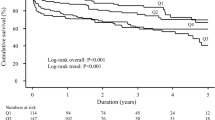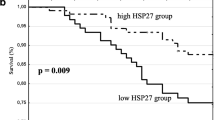Abstract
The relationship between serum anti-heat shock protein (Hsp)27 antibody and high sensitive C-reactive protein (hs-CRP) levels and indices of cardiac function were investigated in patients undergoing coronary artery bypass grafting (CABG) or heart valve replacement. The changes in anti-Hsp27 antibody titers and hs-CRP levels were compared among patients undergoing off-pump and on-pump CABG or valvular heart replacement. Fifty-three patients underwent off-pump, on-pump CABG, and heart valvular replacement in each group. Serum anti-Hsp27 titers and hs-CRP values were measured 24 h before and after the operation and at discharge. Echocardiography was performed before surgery and before discharge. The results were compared with values from 83 healthy controls. hs-CRP levels increased and anti-Hsp27 antibody decreased following surgery (P < 0.001 and P < 0.05, respectively), although these changes were independent of operative procedure (P = 0.361 and P = 0.120, respectively). Anti-Hsp27 antibody levels were higher at the time of discharge (P = 0.016). Only in coronary patients were anti-Hsp27 antibody levels negatively associated with E/E′ (r = −0.268, P = 0.022), a marker of pulmonary capillary wedge pressure. In conclusions, anti-Hsp27 antibody levels are associated with indices of cardiac function in coronary patients. Cardiopulmonary bypass had no significant effect on the induction of changes in anti-Hsp27 levels. Moreover, anti-Hsp27 antibody levels fell in all groups postoperatively; this may be due to the formation of immune complexes of antigen–antibody, and antibody levels were higher at the time of discharge.

Similar content being viewed by others
References
Ascione R, Lloyd CT, Underwood MJ et al (2000) Inflammatory response after coronary revascularization with or without cardiopulmonary bypass. Ann Thorac Surg 69:1198–1204
Atar I, Gulmez O, Atar A et al (2005) The effects of prior beta-blocker therapy on serum C-reactive protein levels after percutaneous coronary intervention. Clin Cardiol 28:243–246
Beatty WL, Morrison RP, Byrne GI (1994) Persistent chlamydiae: from cell culture to a paradigm for chlamydial pathogenesis. Microbiol Rev 58:686–699
Biglioli P, Cannata A, Alamanni F et al (2003) Biological effects of off-pump vs. on-pump coronary artery surgery: focus on inflammation, hemostasis and oxidative stress. Eur J Cardiothorac Surg 24:260–269
Bolli R (1991) Oxygen-derived free radicals and myocardial reperfusion injury: an overview. Cardiovasc Drugs Ther 5(Suppl 2):249–268
Boulanger CM, Scoazec A, Ebrahimian T et al (2001) Circulating microparticles from patients with myocardial infarction cause endothelial dysfunction. Circulation 104:2649–2652
Burke AP, Tracy RP, Kolodgie F et al (2002) Elevated C-reactive protein values and atherosclerosis in sudden coronary death: association with different pathologies. Circulation 105:2019–2023
Clements RT, Sodha NR, Feng J et al (2007) Phosphorylation and translocation of heat shock protein 27 and alphaB-crystallin in human myocardium after cardioplegia and cardiopulmonary bypass. J Thorac Cardiovasc Surg 134:1461–1470
Cleveland JC Jr, Shroyer AL, Chen AY, Peterson E, Grover FL (2001) Off-pump coronary artery bypass grafting decreases risk-adjusted mortality and morbidity. Ann Thorac Surg 72:1282–1288
Davutoglu V, Celik A, Aksoy M (2005) Contribution of selected serum inflammatory mediators to the progression of chronic rheumatic valve disease, subsequent valve calcification and NYHA functional class. J Heart Valve Dis 14:251–256
Eberhardt F, Mehlhorn U, Larose K, De Vivie ER, Dhein S (2000) Structural myocardial changes after coronary artery surgery. Eur J Clin Invest 30:938–946
Fransen E, Maessen J, Dentener M et al (1998) Systemic inflammation present in patients undergoing CABG without extracorporeal circulation. Chest 113:1290–1295
Garcia MJ, Thomas JD, Klein AL (1998) New Doppler echocardiographic applications for the study of diastolic function. J Am Coll Cardiol 32:865–875
Gaspardone A, Crea F, Versaci F et al (1998) Predictive value of C-reactive protein after successful coronary-artery stenting in patients with stable angina. Am J Cardiol 82:515–518
Ghayour-Mobarhan M, Sahebkar A, Parizadeh SM et al (2008) Antibody titres to heat shock protein 27 are elevated in patients with acute coronary syndrome. Int J Exp Pathol 89:209–215
Ghayour-Mobarhan M, Rahsepar AA, Tavallaie S, Rahsepar S, Ferns GA (2009) The potential role of heat shock proteins in cardiovascular disease: evidence from in vitro and in vivo studies. Adv Clin Chem 48:27–72
Giannessi D, Colotti C, Maltinti M et al (2007) Circulating heat shock proteins and inflammatory markers in patients with idiopathic left ventricular dysfunction: their relationships with myocardial and microvascular impairment. Cell Stress Chaperones 12:265–274
Gottsauner-Wolf M, Zasmeta G, Hornykewycz S et al (2000) Plasma levels of C-reactive protein after coronary stent implantation. Eur Heart J 21:1152–1158
Hearse DJ (1990) Ischemia, reperfusion, and the determinants of tissue injury. Cardiovasc Drugs Ther 4(Suppl 4):767–776
Heidari-Bakavoli AR, Sahebkar A, Mobara N et al (2012) Changes in plasma level of heat shock protein 27 after acute coronary syndrome. Angiology 63:12–16
Karu I, Taal G, Zilmer K et al (2010) Inflammatory/oxidative stress during the first week after different types of cardiac surgery. Scand Cardiovasc J 44:119–124
Kazemi-Bajestani SM, Ghayour-Mobarhan M, Ebrahimi M et al (2007) C-reactive protein associated with coronary artery disease in Iranian patients with angiographically defined coronary artery disease. Clin Lab 53:49–56
Lindquist S (1986) The heat-shock response. Annu Rev Biochem 55:1151–1191
Mandal K, Jahangiri M, Xu Q (2005) Autoimmune mechanisms of atherosclerosis. Handb Exp Pharmacol 170:723–743
Martin JL, Mestril R, Hilal-Dandan R, Brunton LL, Dillmann WH (1997) Small heat shock proteins and protection against ischemic injury in cardiac myocytes. Circulation 96:4343–4348
Martin JL, Hickey E, Weber LA, Dillmann WH, Mestril R (1999) Influence of phosphorylation and oligomerization on the protective role of the small heat shock protein 27 in rat adult cardiomyocytes. Gene Expr 7:349–355
Miller JD, Weiss RM, Serrano KM et al (2009) Lowering plasma cholesterol levels halts progression of aortic valve disease in mice. Circulation 119:2693–2701
Moohebati M, Falsoleiman H, Dehghani M et al (2011) Serum inflammatory and immune marker response after bare-metal or drug-eluting stent implantation following percutaneous coronary intervention. Angiology 62:184–190
O’Brien KD (2006) Pathogenesis of calcific aortic valve disease: a disease process comes of age (and a good deal more). Arterioscler Thromb Vasc Biol 26:1721–1728
Pourghadamyari H, Moohebati M, Parizadeh SM et al (2011) Serum antibody titers against heat shock protein 27 are associated with the severity of coronary artery disease. Cell Stress Chaperones 16:309–316
Rahsepar AA, Mirzaee A, Moodi F et al. (2012) Anti-heat shock protein 27 titers and oxidative stress levels are elevated in patients with valvular heart disease. Angiology. doi:10.1177/0003319711433308
Rastan AJ, Eckenstein JI, Hentschel B et al (2006) Emergency coronary artery bypass graft surgery for acute coronary syndrome: beating heart versus conventional cardioplegic cardiac arrest strategies. Circulation 114:I477–I485
Sabik JF, Gillinov AM, Blackstone EH et al (2002) Does off-pump coronary surgery reduce morbidity and mortality? J Thorac Cardiovasc Surg 124:698–707
Schett G, Metzler B, Kleindienst R et al (1999) Myocardial injury leads to a release of heat shock protein (hsp) 60 and a suppression of the anti-hsp65 immune response. Cardiovasc Res 42:685–695
Stollerman GH (1997) Rheumatic fever. Lancet 349:935–942
Szerafin T, Horvath A, Moser B et al (2006) Apoptosis-specific activation markers in on- versus off-pump coronary artery bypass graft (CABG) patients. Clin Lab 52:255–261
Vaage J, Valen G (1993) Pathophysiology and mediators of ischemia–reperfusion injury with special reference to cardiac surgery. A review. Scand J Thorac Cardiovasc Surg Suppl 41:1–18
Acknowledgments
We are particularly grateful to the patients and their family members who volunteered to participate in this study. This work was supported by Mashhad University of Medical Science (MUMS), Iran. The results presented in this work have been taken from Amir Ali Rahsepar’s thesis in MUMS, with the following ID number: 87065.
Conflict of interest
The authors declare no conflict of interest.
Author information
Authors and Affiliations
Corresponding author
Electronic supplementary material
Below is the link to the electronic supplementary material.
ESM 1
(PDF 61.9 kb)
Rights and permissions
About this article
Cite this article
Rahsepar, A.A., Mirzaee, A., Moodi, F. et al. Changes in anti-heat shock protein 27 antibody and C-reactive protein levels following cardiac surgery and their association with cardiac function in patients with cardiovascular disease. Cell Stress and Chaperones 18, 65–74 (2013). https://doi.org/10.1007/s12192-012-0358-y
Received:
Revised:
Accepted:
Published:
Issue Date:
DOI: https://doi.org/10.1007/s12192-012-0358-y




